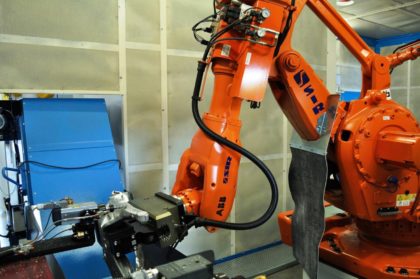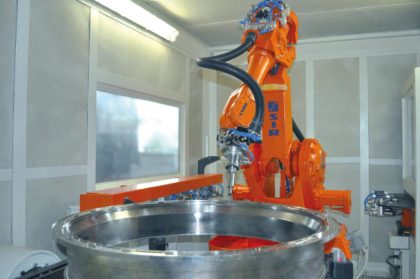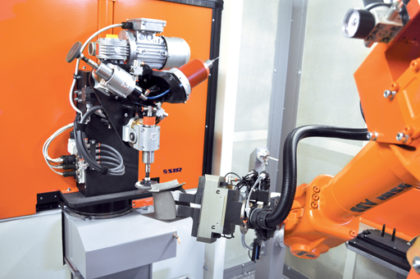The ability to perform high-quality, high-precision process operations opens out new scenarios in the world of industrial automation, transforming robots into real skilled operatives.
Nowadays, process operations carried out by articulated robots, such as cutting, trimming and finishing, are amongst the most popular applications of robotics: this is due to the need to cut production costs and times while simultaneously increasing the quality and reproducibility of industrial products, not to mention the shortage of workers willing to accept unpleasant and potentially unhealthy conditions. SIR Soluzioni Industriali Robotizzate, a robotic system integrator for more than twenty-five years, is the undisputed leader in process applications, involving not only metal machining procedures (on aluminium, cast iron, steel, brass and special alloys) but also operations in less conventional sectors (plastics, composites and ceramics). The know-how SIR has developed is truly impressive: there are now dozens of systems installed in Italy and abroad, with customers ranging from small workshops to large industrial groups. Trimming and similar processes are the most complex robotic projects in view of the precision required: sophisticated mechanical and software solutions are therefore required, especially if the applications involve the machining of complex pieces such as special alloy aerospace components. Basically, the robot has to take the place of the craftsman who performs the trimming, turning or milling operation, becoming a skilled worker in its own right. This means it has to be equipped with tools and “abilities” that enable it to create a finished piece starting from a blank, generally derived from a casting. This skill can be defined as robot manufacturing, contracted to robofacturing.
A FACTORY WITHIN A FACTORY
To create a good process system, every tiny detail of the solution has to be carefully designed. The mechanical and hardware/software components must be of the very highest quality: this can clearly be seen in SIR systems, which consist of monoblock solutions that look like independent little automatic workshops, a factory within the factory, all contained inside a few square metres of space. The robot is the central player, around which the loading, unloading and end effector change units are arranged. It has gripper tools capable of handling various types of pieces, automatically interchangeable and housed in a special magazine. The heart of the system, the Module, is in the working area of the articulated robot itself, in the centre of its area of action. Consisting of a controlled axis operated by the robot itself, the Module is able to contain a variety of machining stations, generally at 90° angles to each other, which can be configured to suit the various types of application: taping, trimming, milling and grinding units, equipped with cutting discs, milling tools and grinding wheels. The robot summons the various types of tool for the different machining phases. The rotating axis then positions them on the working area side, at the ideal angle for the individual trimming, cutting or finishing operation. The use of this patented unit allows processes to be performed in small spaces, which simplifies dust and shaving extraction, cuts cycle times and optimises and facilitates programming: basically, the robot works in the optimal position at all times, with no problems of access to programmed paths. In this solution, applicable in 80% of cases, the robot manipulates the workpiece and supports it during machining. However, installations may also adopt the opposite configuration, where the workpiece is placed on a revolving unit and the robot picks the various tools required for the machining task and automatically fits them on the wrist.
COMPONENTS THAT MAKE THE DIFFERENCE
In a robotic process system, machining quality is achieved through the use of customised components, which make the difference and are the key to the application’s success. In the world of robofacturing, the use of vision systems, adaptive compensation tools and off-line programming software are all essential. Artificial vision is used for picking workpieces from feeding systems which may consist of rotary indexing tables with universal tops, belts, pallets and recently even bins. Thanks to the new 3D technologies introduced in the new proprietary CubicVision vision system, SIR robots are able to pick workpieces directly from a bin of loose items: this is a revolutionary solution, capable of opening out new horizons in industrial manufacturing. But this is not all: these systems are able to inspect the piece to perform dimensional or surface checks, or inspect the state and size of the burrs to adapt the machining program in real time, giving the machine decision-making powers so that it can decide, for example, to perform additional finishing passes. This path recognition function actually allows optical programming of the robot: basically, the path is determined by the profile calculated by the vision system, which transforms the image into a real robot program comprising hundreds of points. This method is applied, for example, on used knives, fed at random in single-piece lot mode, which are sharpened, trimmed and polished by custom-built SIR systems, where the vision system functions as a genuine real-time self-programming tool. And the best is yet to come: these systems work day and night, 24 hours a day, producing pieces of constant high quality. To achieve this aim, the robot must have adaptive qualities; in other words, it must have all the sensitivity of the skilled craftsman. How can this be done? Generally, SIR uses force sensors capable of adapting the robot to variations between the actual piece and its nominal geometry, or passive compensation systems that allow the same purpose to be achieved with a purely mechanical solution. The mechanics and electrics of the spindles designed and built by SIR allow the piece to be “copied” with extreme precision, since they have multidirectional compensation, both radially and along the compression and extension axes. This perfect synthesis of compact design and mechanical performance is backed up by automatic calibration of the compensation pressure (which can be modified point by point during execution of the path) internal pressurisation, lubrication and constant wetting of the milling tools, and the capability for automatic tool cone change during machining, with cones picked from and placed in a special tool magazine. These extraordinary machining aids, which are of course patented, are able to guarantee virtually total copying capacity, through appropriate selection of the force to be applied to the object during machining: the spindle’s sensitivity and precision allow the result to be varied by changing the compensation pressure by just a few tenths of a bar.
This solves the fundamental problem of machining quality, but we are still without an answer to a question every customer asks before purchasing a system of this kind: how long does it take to create a new program, and especially what skill levels are required for this operation?
The new behavioural simulation technologies, procedures and systems on which SIR has been working for some time under an industrial research project involving researchers from top universities, allow programming times to be reduced by 75%, with all operations carried out off-line, i.e. without stopping the system. Thanks to a simulator installed on the computer, which contains a virtual representation of the real system down to the tiniest detail (spindle, robot and external devices), all machining paths can be programmed from the comfort of the office, on the basis of the 3D mathematical drawing of the piece. The program generated, which is error-free and optimised for each single process, will then be sent to the real robot by means of a network connection, ready to be put into production.
MICROTRIMMING: ABSOLUTE PRECISION AND QUALITY
Among the many applications built, it is worth focusing a while on those for trimming aeronautics components, where the quality and precision required are generally extremely high. When machining turbine blades, for example, the bevelling must be accurate to a tenth of a millimetre and absolutely constant. The material is extremely hard, generally consisting of high-titanium special alloys. The systems normally cover a mix of handling and machining processes: a first robot tends the machining centres and handles the fittings that secure the piece on the machine tool. After unloading from the machining unit, the articulated robot places the piece on the trimming station, which generally has a clamping tool with rotation device, to drive the piece and ensure that all paths are perfectly accessible. A second robot then carries out the machining operation as such: the heart of the system comprises pneumatic spindles built by SIR, capable of no less than 100,000 rpm and of taking customised milling tools, with the option of automatic tool change. The use of two-directional or multi-directional compensation systems ensures virtually perfect copying of the piece as the path is performed. It is amazing to think that the compensation system, operated by pressurised air at very low values (even just one bar) is able to regulate the force applied with a sensitivity of just a few grams, with reproducibility of tool return to the central position of the order of a few hundredths of a millimetre, a characteristic unthinkable in commercial spindles. The micro-trimming work obtained is of outstanding quality and the process is then completed by an abrasive disc finishing process which removes the upset burr left by the previous machining operation. Amongst the many installations, mention should also be made of the many automotive industry projects, from shafts and cylinder heads to many other fundamental engine components, such as housings or pump bodies. In future, SIR’s participation in the COMET European research project will allow the achievement of even more ambitious results. Thanks to the use of extremely accurate calibration systems and off-line software programs derived from those developed for machine tools, the aim is to create robotic finishing systems with reproducibility of the order of hundredths of a millimetre. This will probably be achieved using active compensation devices based on piezoelectric technologies and laser or LED tracking systems, able to display and correct the robot’s path in real time in the event of any deviation due to mechanical backlashes.
ROBOTICS IN FOUNDRIES
SIR’s installations have progressed in giant steps even on very heavy components of considerable size: in this case, systems include the Module unit, using tools specifically designed for cutting and trimming materials such as cast iron or steel. In view of these castings’ intrinsic variability, path correction vision systems and off-line programming simulators are an integral part of the solution. Noteworthy projects in this area include the machining of hammers and reduction gearbox bodies for earth-moving machinery or, amongst the very latest installations, the finishing of road manhole frames. In this particular application, SIR has developed an extremely high-performance system, capable of levelling the fundamental planes, shaping the hinge surrounds and the edge of the piece, drilling the water drainage holes and performing general finishing. In spite of the piece’s weight and size, the robot moves with speed and precision, giving a clear idea of how it is possible to create a fully integrated product, in which all key parts (robot and additional components) combine to form a large compact, independent, functional processing centre. This is an outstanding achievement, which shows how far SIR has gone along the road to robofacturing, thanks to the combined use of innovative technologies. This continuous striving for technological improvement clearly demonstrates the philosophy that inspires SIR’s activities: a concept of robotics which is not the mere automation of a manual process, but is able to contribute genuine value-added, by blending efficiency, quality and convenience. The advent of “intelligent” systems cannot be far away.
Davide Passoni
R&D Department
SIR spa






